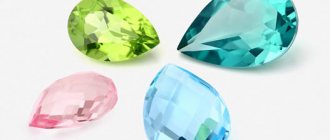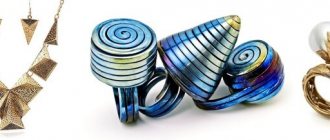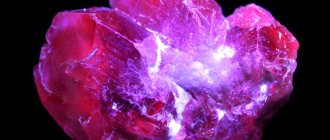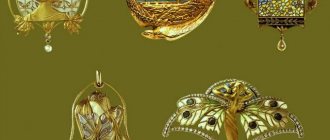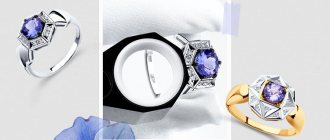Place Vendôme in Paris is the jewelry heart of France. Photo: paris-hotel-mansart.com The rapid rise of French jewelry took place in the 17th century. The whimsical art of Baroque brings into fashion products decorated with fine carvings and voluminous embossed relief. Pearls are especially popular in jewelry. Interest in painting in jewelry arose: bright combinations of multi-colored enamel with gold and precious stones added even more resemblance to the creations of great artists.
Advertising - Continued below
At the end of the 19th - beginning of the 20th centuries, Art Nouveau rose to the top - a style in which France conquered everyone without exception. Jewelry from this trend is not just elegant and beautiful - it hypnotizes the viewer with the smoothness of its lines, their natural interlacing and airiness of shapes.
But let's go back to our time and talk about works of jewelry for which you can drop everything and rush to France. And we will start with brands familiar to many, which have consistently proven their exclusivity for more than one century.
Lalique
Corsage decoration with precious jasmine from Rene Lalique.
1899−1902, Rene Lalique Museum Rene Lalique is perhaps the brightest and most famous representative of modern jewelry. This artist always wanted to create something new, without being afraid to break the usual patterns. And he succeeded: first in the jewelry world, and then in glass production. Thanks to his enormous talent and exorbitant hard work, Lalique became a real nugget of French Art Nouveau (aka Art Nouveau).
One of the revolutionary techniques in Lalique’s work is the use of non-precious materials: copper, brass, turtle shell, horn. Many museums around the world are proud to have works by this master in their exhibitions. Rene Lalique became famous not only as a jeweler - he later became interested in working with glass and subsequently devoted all his creative energy to this material: perfume bottles, figurines and vases did not leave anyone indifferent. In recent years, Rene Lalique has been involved in large-scale work: decorating restaurants and hotels.
Advertising - Continued below
Now Lalique jewelry can be purchased in many cities in France. So, in Paris the boutique is located at 11 rue Royale. On the company's official website you can get complete information about store opening hours.
If buying expensive jewelry is not your goal, but you just want to be inspired by beauty, then in Alsace, in the village of Wingen-sur-Moder in the Vosges Mountains, where Lalique built his glass factory in 1919, there is a museum of the same name, which opened in 2011 . Here you can see about 500 unique works of the master and learn more about René Lalique himself.
Rene Lalique
Rene Lalique was born in 1860 in the province of Champagne. His parents, a wine merchant and a dressmaker, managed to give the young man a good education. Behind him are the prestigious National Higher School of Decorative Arts in Paris (Ecole des arts decoratifs), Sydenham College of Art in London.
Rene was an excellent draftsman and received high awards for his skill. Having completed his studies at the age of 20, he began to take private orders - he came up with wallpaper designs, and worked freelance for several jewelry companies. Everything would be fine, but Lalique was not entirely satisfied with the then concept that dominated jewelry: diamonds should be large and there should be a lot of them. The esthete and inventor Lalique was bored with working with large precious stones: they seemed rough to him.
In 1885, Lalique opened his first studio and began to create for his own pleasure. He experimented with enamels and metals, created amazing shapes, and combined different textures. He had diamonds side by side with amber, gold with moonstone, glass with wood. Butterflies and dragonflies seemed to be about to take off, and the birds were going to sing. Along with insects and flowers, images of thistles, moss, rough tree roots, and spruce paws with cones appeared in Lalique’s jewelry.
Brooch-pendant with the image of Alice Ledru, wife of Rene Lalique. 1900
But the main leitmotif of his work is young beauties in languid and passionate poses. Lalique decorated them with images of brooches and vases, perfume bottles and combs, furniture and even figures on car radiators.
As René Lalique told the French art critic Maximilian Gautier, who interviewed him in 1925: “Women and nature are my main source of inspiration.”
Cartier
Cartier watch with panther: white gold, onyx, diamonds.
It all started in 1847, when the young ambitious Louis-François Cartier bought the workshop from his mentor Adolphe Picard in order to realize his ideas in the field of creating jewelry. In contrast to the Art Nouveau style, which was then gaining popularity, the artist chose for his work the Art Deco direction with its characteristic geometric, strict forms. It was difficult not to notice the extraordinary abilities of the young Cartier, so soon almost the entire elite of French high society became clients of his workshop.
What was special about his jewelry? Cartier introduced animalistic images into fashion: butterflies, beetles, scorpions. Using one of the symbols of Ancient Egypt, he created his scarabs. Before Cartier, using images of insects in jewelry was considered bad manners, but he presented them so skillfully that he managed to make the public fall in love with his jewelry. Louis-François was also one of the first to actively work with platinum, replacing the usual gold and silver with it.
Advertising - Continued below
Visitors to the French capital can head straight to the main Cartier boutique in the center of Paris on the Champs-Elysees, which has recently been renovated and once again shines with its unique chic. However, do not forget that the branded stores of the jewelry house are located in many cities in Europe and beyond. Any necessary information about their location and range can be found on the official website.
“People will make fun of you”
August 1, 1888 is considered the official date of birth of the Lalique jewelry house. Rene Lalique registers his own trademark - an emblem with initials and a sword. From now on, this sign will appear on all his works.
The jeweler worked with any material that was capable of creating the effect he wanted. He often used semi-precious stones - not for reasons of economy, but because of the color and veining. The richness of textures gave Lalique’s creations a real 3D effect. The decorations turned out to be voluminous and multi-layered due to tonal tints and many shades.
Lalique began to gain fans, mainly from the bohemian world. However, serious Houses were in no hurry to recognize him. According to legend, Rene Lalique came to the director of the Boucheron jewelry house with a sketch of a chest decoration that depicted two flying swallows. The director looked, grimaced and explained to the young master that, although it was beautiful, “people will make fun of you.” Too extravagant. But after Lalique finally made the decoration, the shocked director immediately bought it for a large sum.
Corsage decoration “Flock of Swallows”. Circa 1886–1887
Rene Lalique, as we would say today, got into the trend, and with the precision of a sniper. In the last decades of the 19th century, the Art Nouveau style with its love for the plant world, female images, grotesque, exotic subjects and flowing forms gained momentum in European art. Lalique essentially became the first artist to implement this style in jewelry.
Boucheron
Hôtel Particulier ring from the Boucheron high jewelery collection.
In general, there are quite a few famous jewelry dynasties in France. And Boucheron certainly is one of them: their jewelry captivates with its beauty, and the history of this brand goes back more than 150 years. The Boucheron jewelry house itself was opened in 1895, but the founding father of the glorious dynasty of jewelers, Frederic Boucheron, began his work even earlier - 1853−1870. Boucheron's clients have included an Indian prince, the Shah of Persia, the Russian royal family and celebrities such as Sarah Bernhardt and Edith Piaf.
This well-deserved success is due to the tireless work and talent of the jewelry house’s artists. Frederic Boucheron skillfully combined in his products such materials as platinum and ivory, diamonds and wood, gold and tortoiseshell, steel and glass. The master loved to create jewelry in the so-called Marie Antoinette style, which corresponds to the style of the 18th century. In addition, Frédéric Boucheron was very sympathetic to Egyptian and Chinese motifs, which were very popular during that period.
French jewelry brands
France has always been a unique country, it was here that the passions of the royal court raged: jealousy and love, intrigue and envy, chic and splendor. It is not surprising that all these feelings are reflected in the jewelry of French jewelry brands. Their products are stunning with their grace, secularity, uniqueness and sophistication.
France! The most famous names in the jewelry firmament were born here and still live here: luxury jewelry brands Cartier, Boucheron, VanCleef&Arpels. The jewelry of these famous jewelry brands are not just expensive accessories, but genuine masterpieces of jewelry art, many of which have found their place in the largest museums in the world.
The history of most French jewelry brands began in a period of time when kings and queens, favorites and favorites, ruled in France. Many jewelers began by fulfilling private orders from crowned heads, because at that time jewelry from famous brands was wildly popular, allowing them to gain the favorable attention of rather fastidious ladies and gentlemen.
The designs of French jewelry brands were so unique and perfect that they were worn by the monarchs of Germany, Monaco, and Spain. To this day, France is the ancestor of the most elite jewelry brands, embodying quality, jewelry traditions, craftsmanship and perfection.
There are not many jewelry brands whose history is closely studied, the work of master jewelers is taken as a basis, precious items are copied, and techniques are passed on from one generation to another. And most of these global jewelry brands are located in France.
It is also important that in France, world jewelry brands have long-standing and firmly established traditions. However, companies do not just rigidly follow the techniques of the past; luxury jewelry brands are constantly improving the craft of creating jewelry, looking for new approaches and directions, following modern laws and ultimately creating completely unique jewelry that is recognized all over the world.
The jewelry social network invites you to immerse yourself in the romantic and exquisite history of French jewelry brands, enjoy the romance and feelings of famous jewelers, and see stunning masterpieces of jewelry that are forever imprinted in our hearts.
Van Cleef & Arpels
Van Cleef & Arpels jewelery watch with hidden dial.
The history of another French brand began with a very pleasant event - a wedding. Representatives of two families, whose main activity was trading in precious stones, tied themselves to Hymen. Estelle Arpels and Alfred Van Cleef got married in 1896. And in 1906, Van Cleef teamed up with his wife’s brothers and opened a jewelry store.
To create magnificent pieces, the young brand sourced the finest gemstones from all over the world. Van Cleef & Arpels did not follow the ever-changing fashion, preferring to create it, which they did very well. The success of their brilliant products allowed them to expand their business - the first boutique in America opened in 1939. Van Cleef & Arpels is considered the inventor of the so-called “invisible” setting (from the English “invisible”), when precious stones form a single surface without burdening the composition of the product with additional castings.
If you find yourself in Paris, you can visit the Van Cleef & Arpels boutique at 20−22 Place Vendôme. Stores in other cities and countries can be found on the brand’s website.
In general, I would like to note that if you want to be in the very heart of the jewelry world of France, then you can safely go to Place Vendôme - this is where many famous jewelry houses were born, and those that opened in another place certainly appeared there later. On the square you can find boutiques of both star brands and young talented designers.
Advertising - Continued below
Clouds are glass
Even at the beginning of his jewelry career, Lalique faced a problem. He could depict any natural detail - flowers, animals, insects. But he couldn't get enough of the clouds. Finally, the artist realized: clouds are glass and crystal!
Love for glass is a special page in Rene’s biography. He loved this material so much that in 1891 he invented and patented his own method of working with it - “pâte de verre” (“glass paste”). And since 1907, he began making bottles for the perfume of the famous perfumer Francois Coty and other famous houses - Worth, D'Orsay, Roger & Gallet. (Nina Ricci still uses Lalique crystal bottles today). Each bottle is a separate work of art, each one “walled up” with Lalique’s favorite image: a naked girl, a dragonfly or a butterfly.
The final turn to glass happened in 1912. Lalique decided to completely break with the jewelry theme and become a glassblower. He first acquired a small factory in Combe-la-Ville, and then a large one in Alsace, in the town of Vingen-sur-Moderet. I experimented with glass all day long, but paying attention to the norms and canons, as I once did with jewelry. Along the way, he invented several new methods of working with this material, and came up with a recipe for opalescent glass (still a company secret). Of course, his vases are decorated with figures of naked bacchantes, and dragonflies sit on powder compacts.
It must be said that here, too, Lalique got the trend right. By that time, the Art Nouveau style began to fade away: in the age of technological progress, admiring nature had become unfashionable. Rene Lalique switched to technology: he made glass sculptures for car radiators (Henri Citroën was his first customer), he designed the carriages of the Orient Express and the 1st class dining room of the Normandy steamship.
If in his youth Rene Lalique gravitated towards miniatures, then in his later years he began to be fascinated by large forms. He designed fountains and decorated restaurants, made light panels for hotels and created crystal lamps. In the twentieth century, romantic dragonflies were replaced by practical things.
Paris Flea Markets - Treasure Hunt Game
If you want something special, then do not forget that Paris is a multifaceted city, you can find almost everything here. So, opposite the Louvre, on the Rue de Rivoli, there is an antique gallery that sells a lot of jewelry (mostly vintage), the average cost of which is about 450 euros.
Flea markets will also provide many discoveries, where you can find the most unusual and unexpected products. So take cash (cards are not accepted in the markets even in Paris), be patient and go ahead in search of your treasure. Just remember that many of the markets are only open on weekends.
The addresses and opening hours of the most famous flea markets in Paris are as follows:
Market Marché St Ouen/Porte de Clignancourt
marcheauxpuces-saintouen.com
Advertising - Continued below
Flea market Saint-Ouen. Photo: blog.bufettaburet.ru
Address: Go to Porte de Clignancourt metro station (Line 4), then follow the road signs. The market is located between the 18th arrondissement of Paris and the northern borders of the St. Ouen district. (Google maps)
Market opening hours: 9:00–18:00 on Saturdays; 10:00−18:00 on Sundays. Free admission.
Market Marché aux Puces de la Porte de Vanves
pucesdevans.typepad.com
Flea market Porte de Vanves. Photo: ispywithmygreeneyes.wordpress.com
Address: Avenue Georges Lafenestre and Avenue Marc Sangnier, 14th arrondissement of Paris. Porte de Vanves metro station (Line 13). (Google maps)
Advertising - Continued below
Market opening hours: 7:00–14:00 every Saturday and Sunday. Free admission.
Market Marché aux Puces de Montreuil
Flea market Porte de Montreuil.
Photo: parisdimanche.com Address: Avenue de la Porte de Montreuil. Porte de Montreuil metro station. (Google maps)
Market opening hours: 7:00–19:30 on Saturdays, Sundays and Mondays. Free admission.
Viren Bhagat
Almost raised within the walls of a department store run by his parents, Viren found his calling in creating miniature, precious works of art. Following his inspiration, Bhagat skillfully embodies a combination of native Indian culture and Art Deco aesthetics in his products.
The talented jeweler was nicknamed “Indian JAR” for the vibrant artistry of his jewelry: Viren first carefully designs each of them on paper, and only after that presents it to his team of experienced craftsmen for judgment.
The Bhagat Jewelry House produces about 60 pieces of jewelry every year, predominantly using precious stones such as rubies, sapphires, emeralds and diamonds.
Advertising - Continued below
Jewelry Museum in Paris
Perhaps purchasing jewelry is not part of your plans, then you can simply admire the beautiful works at the Paris Museum of Decorative and Applied Arts. This one of the richest museums in Europe is located in the western wing of the Louvre, and opened its doors to its first visitors back in 1905. A variety of luxurious furniture, dishes, accessories and, of course, jewelry from different eras will tell about the lifestyle of the rich and famous residents of France. It is also another place where you can enjoy the creations of René Lalique.
Most likely, you will not have any difficulty finding the famous Louvre, but, just in case, we will mention the address of the museum: 107, rue de Rivoli.
France is one of the brightest countries in Europe, and it is difficult to imagine jewelry tourism without visiting this extraordinary romantic place.
Revolutionaries choose... butterflies
You may ask, where has the spirit of adventurism gone, with which the young Rene Lalique once embarrassed the Parisian bourgeoisie? Has the jewelry house really turned into a quiet, decent store of expensive vases and wardrobes in more than a hundred years? Who is embarrassing the public now? There's nothing wrong with that. Lalique regularly invites contemporary artists and architects to collaborate and allows them to “have a blast” to the fullest. For example, the scandalous partygoer and artist Terry Rogers, who painted the nightlife of New York bohemia from the inside, reinterpreted Lalique’s “The Bacchae.” In Rogers' version, the girls on the vases turned out to be some kind of models from nightclubs, inviting acquaintance. Architect Zaha Hadid created a collection of black and white crystal vases based on Lalique's natural motifs. And the main provocateur of our time, the artist Damien Hirst, took part in the creation of 12 multi-colored panels depicting butterflies. Like Lalique in his time, he has a tender love for these insects. Apparently, this is a common point for revolutionaries.
Lalique. Vase from the Anemone collection.
